View in other NatureServe Network Field Guides
NatureServe
Montana
Utah
Wyoming
Idaho
Wisconsin
British Columbia
South Carolina
Yukon
California
New York
Tawny-edged Skipper - Polites themistocles
Native Species
Global Rank:
G5
State Rank:
S5
Agency Status
USFWS:
USFS:
BLM:
External Links
General Description
[From Ferris and Brown 1981; Scott 1986; Layberry 1998; Opler and Wright 1999; Glassberg 2001; Pyle 2002] Forewing 1.2-1.3 cm. Small, forewing slightly rounded. Uppersurface of forewing drab olive with tawny-orange along costal margin invading end of cell, male stigma sinuous in 3 segments with interior tan felt, male scale patch outside stigma connects with dark wing margin, hindwing unmarked drab olive; undersurface of hindwing brassy orange-brown or gray, sometimes with postmedian band of pale spots.
Phenology
One flight, mid-June through July northward and in the Rocky Mountains, several flights, June to August at lower elevation and in the East, all year in Florida (Scott 1986). Mainly June and July in one brood areas, May to September in two brood areas (Glassberg 2001). Early June to late July across Canada (Layberry et al. 1998). Late May to August in the Rocky Mountain states (Ferris and Brown 1981). Mid-June to late August in Colorado (Scott and Scott 1978), mid-May to early August in Nebraska (Johnson and Nixon 1967; Dankert and Nagel 1988), mid-June to late July in North Dakota (McCabe and Post 1976), late May to early August in Washington (Pyle 2002), early June to late July in British Columbia (Threatful 1988; Guppy and Shepard 2001).
Diagnostic Characteristics
Best determined by a combination of small size, upersurface of forewing drab-olive with contrasting orange along costal margin, the male forewing stigma in 3 segments, hindwing unmarked; undersurface of hindwing orange-brown to gray and usually unmarked (sometimes with postmedian band of pale spots).
Species Range
Montana Range
Range Descriptions
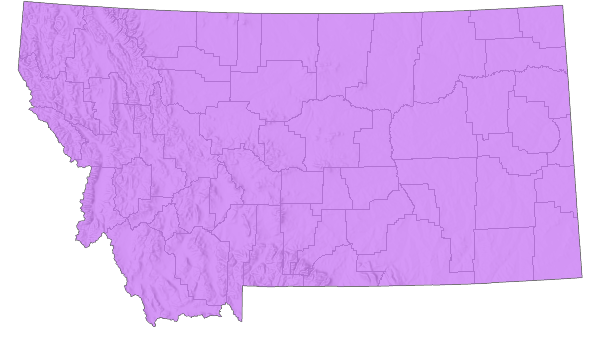
 Native
Native
Range Comments
Southern British Columbia and northeastern Washington, east across southern Canada to Nova Scotia, south to central Arizona, southern New Mexico, southeastern Texas, the Gulf Coast, and central Florida; isolated populations in northern California and western Oregon (Scott 1986; Layberry et al. 1998; Opler and Wright 1999; Glassberg 2001; Guppy and Shepard 2001; Pyle 2002; Warren 2005); to about 2743 m elevation in the Rocky Mountain states (Ferris and Brown 1981), up to 3200 m elevation in Colorado (Brown 1957; Scott and Scott 1978), to at least 914 m elevation Washington (Pyle 2002), to at least 610 m elevation in southeastern British Columbia (Threatful 1988). In Montana, reported from at least 25 counties across the state with the exception of the north-central region (Kohler 1980; Stanford and Opler 1993; FLMNH Lepidopterists' Society database), to at least 1860 m elevation. Common in two brood areas, uncommon in one-brood areas, which include Montana (Glassberg 2001).
Observations in Montana Natural Heritage Program Database
Number of Observations: 3
(Click on the following maps and charts to see full sized version)
Map Help and Descriptions
Relative Density
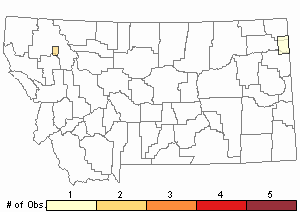
Recency
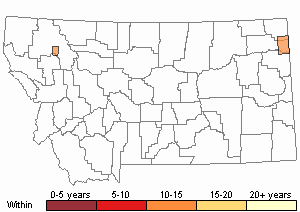
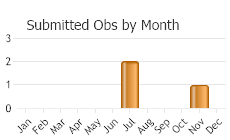
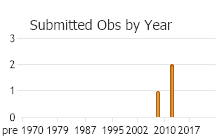
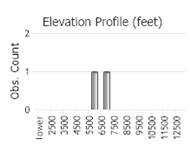 (Observations spanning multiple months or years are excluded from time charts)
(Observations spanning multiple months or years are excluded from time charts)
Migration
Non-migratory.
Habitat
Montane meadows, lawns, pastures, vacant lots, roadsides, dry and wet native prairie, marsh and pond margins (Clench 1967; Ferris and Brown 1981; Scott 1986; Dankert and Nagel 1988; Threatful 1988; Layberry et al. 1998; Opler and Wright 1999; Glassberg 2001; Guppy and Shepard 2001; Pyle 2002). More abundant in midwestern native prairie than old fields and barrens (Swengel and Swengel 2015). Habitat in Montana not described but probably similar.
Food Habits
Larval food plants are grasses, including Dichanthelium, Digitaria, Glyceria, Koeleria, Panicum, and Poa, and sedges, including Carex; also Cynodon in captivity (Ferris and Brown 1981; Scott 1986, 1992, 2006; Layberry et al. 1998; Guppy and Shepard 2001; Pyle 2002; Warren 2005; James and Nunnallee 2011). Adults feed on flower nectar (including Apocynum, Asclepias, Astragalus, Bidens, Boltonia, Buddleja, Carduus, Centaurea, Centranthus, Cephalanthus, Chrysanthemum, Cirsium, Convolvulus, Coreopsis, Cornus, Dalea, Delphinium, Echinacea, Erigeron, Eryngium, Eupatorium, Gomphrena, Hedysarum, Helenium, Helianthus, Heliopsis, Iris, Jamesia, Lespedeza, Liatris, Linaria, Lobelia, Lupinus, Lychnis, Lycopus, Lythrum, Medicago, Melilotus, Monarda, Oenothera, Oxypolis, Oxytropis, Pastinaca, Phacelia, Phlox, Phyla, Polygonum, Prunella, Pycnanthemum, Rubus, Rudbeckia, Sagittaria, Salvia, Sedum, Silphium, Stachys, Symphoricarpos, Tagetes, Taraxacum, Trifolium, Verbena, Veronica, Vicea, Zinnia) and mud (Bray 1994; Reed 1997; Tooker et al. 2002; Scott 2014).
Reproductive Characteristics
Females lay eggs singly on or near host plant on the undersides of leaves (Scott 1986, 1992). Eggs hatch in 9 days (depending on temperature), develop to L3 instar in about 35 days (depending on temperature) while most develop to L5 instar and pupae in about 40 days post egg-hatch, diapause (overwinter) as pupae although half-grown (L3 instar) larvae may overwinter in some situations, adults eclose (emerge from pupae) in about 10 days (James and Nunnallee 2011). Larvae eat host plant leaves, build nests of dead and live grass tied with silk, pupate in a stronger nest on ground or a base of grass, overwinter as pupae or half-grown larvae (Scott 1979, 1986, 1992; James and Nunnallee 2011). Males perch throughout the day in grassy swales, depressions in lawns, valley bottoms, awaiting passing females (Scott 1975b, 1986).
Stewardship Responsibility
References
- Literature Cited AboveLegend:
 View Online Publication
View Online Publication Bray, T. 1994. Nectar-seeking visits by butterflies in a tallgrass prairie remnant in eastern Nebraska. Transactions of the Nebraska Academy of Sciences. 21:63-72.
Bray, T. 1994. Nectar-seeking visits by butterflies in a tallgrass prairie remnant in eastern Nebraska. Transactions of the Nebraska Academy of Sciences. 21:63-72. Clench, H.K. 1967. Temporal dissociation and population regulation in certain hesperiine butterflies. Ecology.48:1000-1006.
Clench, H.K. 1967. Temporal dissociation and population regulation in certain hesperiine butterflies. Ecology.48:1000-1006. Dankert, N.E. and H.G. Nagel. 1988. Butterflies of the Niobrara Valley Preserve, Nebraska. Transactions of the Nebraska Academy of Sciences 16:17-30.
Dankert, N.E. and H.G. Nagel. 1988. Butterflies of the Niobrara Valley Preserve, Nebraska. Transactions of the Nebraska Academy of Sciences 16:17-30. Ferris, C.D. and F.M. Brown (eds). 1981. Butterflies of the Rocky Mountains. Univ. of Oklahoma Press. Norman. 442 pp.
Ferris, C.D. and F.M. Brown (eds). 1981. Butterflies of the Rocky Mountains. Univ. of Oklahoma Press. Norman. 442 pp. Glassberg, J. 2001. Butterflies through Binoculars: A Field Guide to the Butterflies of Western North America. Oxford University Press.
Glassberg, J. 2001. Butterflies through Binoculars: A Field Guide to the Butterflies of Western North America. Oxford University Press. Guppy, C.S. and J.H. Shepard. 2001. Butterflies of British Columbia: including western Alberta, southern Yukon, the Alaska Panhandle, Washington, northern Oregon, northern Idaho, northwestern Montana. UBC Press (Vancouver, BC) and Royal British Columbia Museum (Victoria, BC). 414 pp.
Guppy, C.S. and J.H. Shepard. 2001. Butterflies of British Columbia: including western Alberta, southern Yukon, the Alaska Panhandle, Washington, northern Oregon, northern Idaho, northwestern Montana. UBC Press (Vancouver, BC) and Royal British Columbia Museum (Victoria, BC). 414 pp. James, D.G. and D. Nunnallee. 2011. Life histories of Cascadia butterflies. Corvallis, OR: Oregon State University Press. 447 p.
James, D.G. and D. Nunnallee. 2011. Life histories of Cascadia butterflies. Corvallis, OR: Oregon State University Press. 447 p. Johnson, K. and E. S. Nixon. 1967. The Rhopalocera of northwestern Nebraska. American Midland Naturalist 78:508-528.
Johnson, K. and E. S. Nixon. 1967. The Rhopalocera of northwestern Nebraska. American Midland Naturalist 78:508-528. Kohler, S. 1980. Checklist of Montana Butterflies (Rhopalocera). Journal of the Lepidopterists' Society 34(1): 1-19.
Kohler, S. 1980. Checklist of Montana Butterflies (Rhopalocera). Journal of the Lepidopterists' Society 34(1): 1-19. Layberry, R.A., P.W. Hall, and J.D. LaFontaine. 1998. The Butterflies of Canada. University of Toronto Press. 280 pp. + color plates.
Layberry, R.A., P.W. Hall, and J.D. LaFontaine. 1998. The Butterflies of Canada. University of Toronto Press. 280 pp. + color plates. McCabe, T.L. and R.L. Post. 1976. North Dakota butterfly calendar (including possible strays). Journal of Research on the Lepidoptera 15:93-99.
McCabe, T.L. and R.L. Post. 1976. North Dakota butterfly calendar (including possible strays). Journal of Research on the Lepidoptera 15:93-99. Opler, P.A. and A.B. Wright. 1999. A field guide to western butterflies. Second edition. Peterson Field Guides. Houghton Mifflin Company, Boston, Massachusetts. 540 pp.
Opler, P.A. and A.B. Wright. 1999. A field guide to western butterflies. Second edition. Peterson Field Guides. Houghton Mifflin Company, Boston, Massachusetts. 540 pp. Pyle, R.M. 2002. The butterflies of Cascadia: a field guide to all the species of Washington, Oregon, and surrounding territories. Seattle Audubon Society, Seattle, Washington. 420 pp.
Pyle, R.M. 2002. The butterflies of Cascadia: a field guide to all the species of Washington, Oregon, and surrounding territories. Seattle Audubon Society, Seattle, Washington. 420 pp. Reed, C.C. 1997. Diurnal Lepidoptera of native and reconstructed prairies in eastern Minnesota. Journal of the Lepidopterists' Society 51:179-184.
Reed, C.C. 1997. Diurnal Lepidoptera of native and reconstructed prairies in eastern Minnesota. Journal of the Lepidopterists' Society 51:179-184. Scott, J.A. 1975b. Mate-locating behavior of western North American butterflies. Journal of Research on the Lepidoptera 14:1-40.
Scott, J.A. 1975b. Mate-locating behavior of western North American butterflies. Journal of Research on the Lepidoptera 14:1-40. Scott, J.A. 1979. Hibernal diapause of North American Papilionoidea and Hesperioidea. Journal of Research on the Lepidoptera 18(3): 171-200.
Scott, J.A. 1979. Hibernal diapause of North American Papilionoidea and Hesperioidea. Journal of Research on the Lepidoptera 18(3): 171-200. Scott, J.A. 1986. The butterflies of North America: a natural history and field guide. Stanford University Press, Stanford, California.
Scott, J.A. 1986. The butterflies of North America: a natural history and field guide. Stanford University Press, Stanford, California. Scott, J.A. 1992. Hostplant records for butterflies and skippers (mostly from Colorado) 1959-1992, with new life histories and notes on oviposition, immatures, and ecology. Papilio new series #6. 185 p.
Scott, J.A. 1992. Hostplant records for butterflies and skippers (mostly from Colorado) 1959-1992, with new life histories and notes on oviposition, immatures, and ecology. Papilio new series #6. 185 p. Scott, J.A. 2006. Butterfly hostplant records, 1992-2005, with a treatise on the evolution of Erynnis, and a note on new terminology for mate-locating behavior. Papilio new series #14. 74 p.
Scott, J.A. 2006. Butterfly hostplant records, 1992-2005, with a treatise on the evolution of Erynnis, and a note on new terminology for mate-locating behavior. Papilio new series #14. 74 p. Scott, J.A. 2014. Lepidoptera of North America 13. Flower visitation by Colorado butterflies (40,615 records) with a review of the literature on pollination of Colorado plants and butterfly attraction (Lepidoptera: Hersperioidea and Papilionoidea). Contributions of the C.P. Gillette Museum of Arthopod Diversity. Fort Collins, CO: Colorado State University. 190 p.
Scott, J.A. 2014. Lepidoptera of North America 13. Flower visitation by Colorado butterflies (40,615 records) with a review of the literature on pollination of Colorado plants and butterfly attraction (Lepidoptera: Hersperioidea and Papilionoidea). Contributions of the C.P. Gillette Museum of Arthopod Diversity. Fort Collins, CO: Colorado State University. 190 p. Scott, J.A. and G.R. Scott. 1978. Ecology and distribution of the butterflies of southern central Colorado. Journal of Research on the Lepidoptera 17(2): 73-128.
Scott, J.A. and G.R. Scott. 1978. Ecology and distribution of the butterflies of southern central Colorado. Journal of Research on the Lepidoptera 17(2): 73-128. Stanford, R.E. and P.A. Opler. 1993. Atlas of western USA butterflies: including adjacent parts of Canada and Mexico. Unpubl. Report. Denver and Fort Collins, Colorado 275 pp.
Stanford, R.E. and P.A. Opler. 1993. Atlas of western USA butterflies: including adjacent parts of Canada and Mexico. Unpubl. Report. Denver and Fort Collins, Colorado 275 pp. Swengel, A.B and S.R. Swengel. 2015. Grass-skipper (Hesperiinae) trends in midwestern USA grasslands during 1988-2013. Journal of Insect Conservation 19:279-292.
Swengel, A.B and S.R. Swengel. 2015. Grass-skipper (Hesperiinae) trends in midwestern USA grasslands during 1988-2013. Journal of Insect Conservation 19:279-292. Threatful, D.L. 1988. A list of the butterflies and skippers of Mount Revelstoke and Glacier National Parks, British Columbia, Canada (Lepidoptera). Journal of Research on the Lepidoptera 27(3-4): 213-221.
Threatful, D.L. 1988. A list of the butterflies and skippers of Mount Revelstoke and Glacier National Parks, British Columbia, Canada (Lepidoptera). Journal of Research on the Lepidoptera 27(3-4): 213-221. Tooker, J.F., P.F. Reagel, and L.M. Hanks. 2002. Nectar sources of day-flying lepidoptera of central Illinois. Annals of the Entomological Society of America 95(1): 84-96.
Tooker, J.F., P.F. Reagel, and L.M. Hanks. 2002. Nectar sources of day-flying lepidoptera of central Illinois. Annals of the Entomological Society of America 95(1): 84-96. Warren, A.D. 2005. Lepidoptera of North America 6: Butterflies of Oregon, their taxonomy, distribution, and biology. Contributions of the C. P. Gillette Museum of Arthropod Diversity, Colorado State University. Fort Collins, Colorado. 406 pp.
Warren, A.D. 2005. Lepidoptera of North America 6: Butterflies of Oregon, their taxonomy, distribution, and biology. Contributions of the C. P. Gillette Museum of Arthropod Diversity, Colorado State University. Fort Collins, Colorado. 406 pp.
- Additional ReferencesLegend:
 View Online Publication
View Online Publication
Do you know of a citation we're missing? Allen, T.J., J.P. Brock, and J. Glassberg. 2005. Caterpillars in the field and garden: a field guide to the butterfly caterpillars of North America. Oxford University Press.
Allen, T.J., J.P. Brock, and J. Glassberg. 2005. Caterpillars in the field and garden: a field guide to the butterfly caterpillars of North America. Oxford University Press. Brock, J.P. and K. Kaufman. 2003. Kaufman Field Guide to Butterflies of North America. Houghton Mifflin Company, New York, NY 284 pp.
Brock, J.P. and K. Kaufman. 2003. Kaufman Field Guide to Butterflies of North America. Houghton Mifflin Company, New York, NY 284 pp. Forister, M.L., C.A. Halsch, C.C. Nice, J.A. Fordyce, T.E. Dilts, J.C. Oliver, K.L. Prudic, A.M. Shapiro, J.K. Wilson, J. Glassberg. 2021. Fewer butterflies seen by community scientists across the warming and drying landscapes of the American West. Science 371:1042-1045.
Forister, M.L., C.A. Halsch, C.C. Nice, J.A. Fordyce, T.E. Dilts, J.C. Oliver, K.L. Prudic, A.M. Shapiro, J.K. Wilson, J. Glassberg. 2021. Fewer butterflies seen by community scientists across the warming and drying landscapes of the American West. Science 371:1042-1045. Forister, M.L., E.M. Grames, C.A. Halsch, K.J. Burls, C.F. Carroll, K.L. Bell, J.P. Jahner, et al. 2023. Assessing risk for butterflies in the context of climate change, demographic uncertainty, and heterogeneous data sources. Ecological Monographs 93(3):e1584. https://doi.org/10.1002/ecm.1584
Forister, M.L., E.M. Grames, C.A. Halsch, K.J. Burls, C.F. Carroll, K.L. Bell, J.P. Jahner, et al. 2023. Assessing risk for butterflies in the context of climate change, demographic uncertainty, and heterogeneous data sources. Ecological Monographs 93(3):e1584. https://doi.org/10.1002/ecm.1584
- Web Search Engines for Articles on "Tawny-edged Skipper"
- Additional Sources of Information Related to "Insects"





